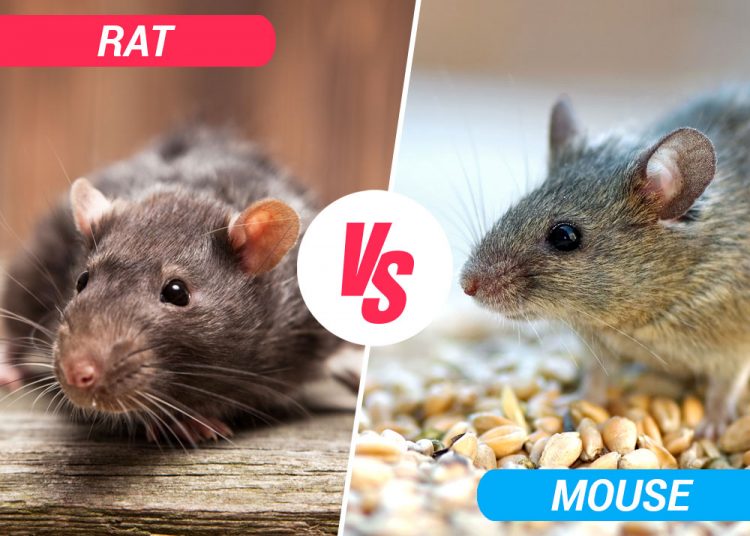Having a rodent pest in the house isn’t fun.
These destructive invaders can do a lot of damage – chewing through wires, nibbling your pantry staples, and even bringing in bacteria.
You might think it doesn’t matter who’s doing the damage – rat or mouse – but it’s tough to get rid of rodents unless you know exactly what you’re dealing with. Effective eradication depends on knowing your enemy and understanding their habits and behaviors.
This quick guide will dive into some of the main differences between rats and mice. If applicable, it will also help you determine which is at work in your home and discover how to get rid of them for good.
What’s the difference between rats and mice?
So a small, furry creature just scurried across your kitchen floor. What was it?
It may have moved too quickly for you to get a good look, but perhaps you noticed a few things about its appearance that can clue you in.
Rat vs mouse – size
The first thing to note is size. If the rodent was on the small side, it’s probably a mouse.
The common house mouse is about half the size of a rat, measuring around 3 inches from snout to tail.
They also have smaller heads, with long pointy noses and small ears. Rats tend to have larger heads and blunt noses.
Rats are also fatter, so if your rodent looks a bit bulky, it’s probably not a mouse.
Rat vs mouse – coat and tail
If you managed to catch more than a glimpse of your rodent, its coat and tail could provide even more clues.
Both mice and rats come in three colors – white, brown, and gray – but a rat’s fur is coarser and more bristly than its mouse cousin’s.
If your creature has dark, dense fur, it’s probably a rat (especially if a long, thick tail accompanies that dark fur).
Rat tails are thicker, scalier, and less hairy than mouse tails. They’re also lighter. A mouse’s tail is more likely to match the color of its fur, while a rat’s tail is generally a pale pink.
Rat droppings or mouse droppings?
You may not see your rodent houseguests, but you’ll definitely know they’re there from the ‘gifts’ they leave around the place.
One of the more disgusting things about sharing your home with these pests is finding their pellet-like droppings everywhere.
They may be gross and messy, but these droppings are another vital clue. By taking a closer look (sorry!), you can easily identify whether they’re rat poop or mouse poop.
If the droppings are rounded and quite large (over 7mm long), they’re probably from a rat. If they’re shorter than 7mm and pointed, they were most likely left by a mouse.
Both rat and mouse poop are dark in color. If the droppings appear moist, they’re fresh, and if they look dried up, they might’ve been lying there for some time.
And if you find yourself constantly sweeping up poop, it’s a good sign that you’re dealing with mice.
These active rodents can poop out a whopping 100 droppings a day. Rats are less productive, clocking in at around 50 poop pellets per day.
Rat or mouse – how do I get rid of them?
Ok, so perhaps you’re not here for a lesson in rodent biology. Perhaps you want to know how to get rid of the tiny terrors?
The best way to get rid of mice
Mice are pretty timid. These nocturnal nuisances will do most of their damage when you’re asleep, making them difficult to catch in the act. They can also squeeze through the tiniest of cracks and holes, giving them plenty of entry points.
The good news (for you!) is that mice are naturally curious. Put down a trap, especially one baited with food, and they’ll be very keen to check it out.
Forget the stereotype of loading the trap with cheese. Mice much prefer nuts and seeds, and they love fatty foods, so peanut butter is a great choice. Sticky foods are also good as they encourage the mouse to linger, activating the trap.
Mouse populations breed quickly, so you’ll probably need to set the bait stations or traps for a while before seeing results. If you’re dealing with a real infestation, call in the professionals.
Once you’ve got rid of the mice currently occupying the house, it’s important to plan and prevent future re-infestations.
Seal up any holes or cracks in the house, especially around doorways and windows. Keep all food in sealed containers, and consider using fragrant deterrents such as peppermint oil.
The best way to get rid of rats
With greater jaw strength and a bigger bite, rats tend to be more destructive than mice. Unless this is a pet situation, it’s important to get rid of them quickly and effectively.
These rodents are much more cautious than mice and won’t be as easy to ensnare. You’ll need to be patient to catch them.
Like mice, you can use bait stations or traps but check the label to make sure they’re suitable for rats. They need to be large enough to cope with the bigger rodents, especially if you’re using a snap trap.
While you might place traps in the attic or upper floors for mice, rats prefer the lower levels of a house, so starting in the basement is generally a good idea.
Rat traps are larger and more dangerous, so it’s essential to keep them away from areas where small children and pets could come across them.
And don’t forget to check them regularly. Dead rodents and food bait are not a combo you want lying around (as they’ll attract even more critters).
As with mice, you can prevent rats from resurfacing by making your home less inviting. Properly store food, watch your water sources (seal up dripping taps or pipes), and repair any gaping entry points.






